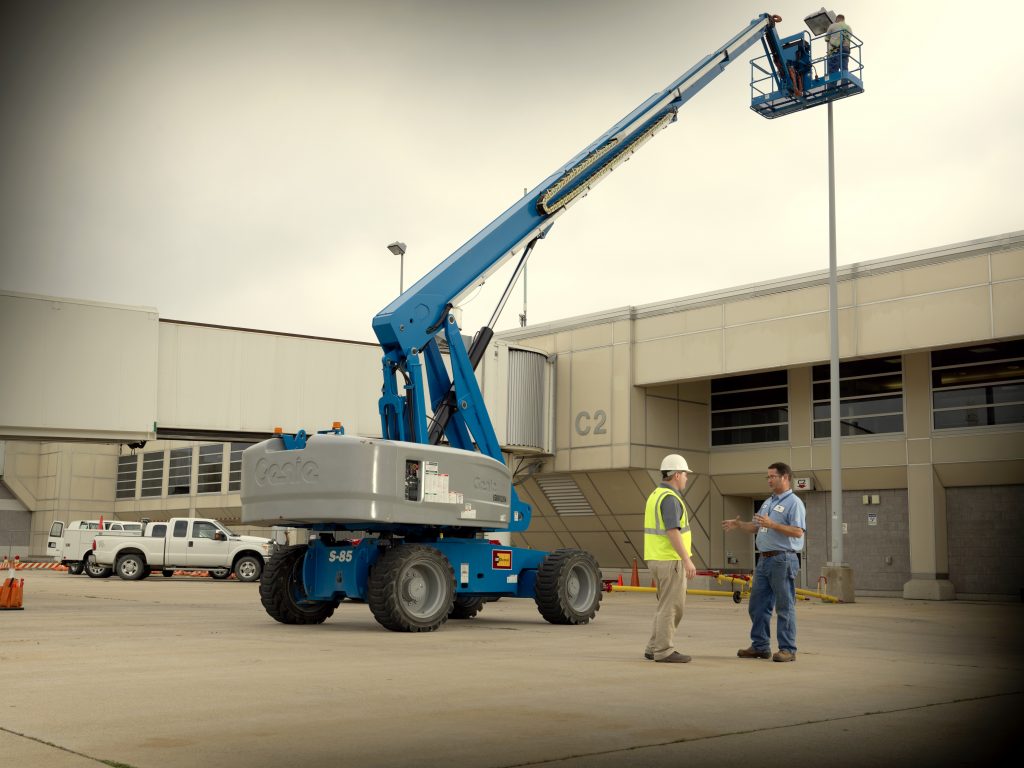
Aerial lifts are used in a wide variety of industries but are particularly useful in many construction environments. Whether you are needing to perform maintenance in some hard to reach areas or are installing ductwork, piping and heating and cooling units, often the most efficient method of installation or maintenance will require the use of an aerial lift.
There are three common types of aerial lifts used in the construction industry – a boom lift, scissor lift and telehandlers. All three have unique characteristics that make them ideal for different applications. Here is a look at each type of lift and how they are best utilized:
Boom Lift
Boom lifts, also commonly referred to as man lift or cherry pickers, are lifts that consist of a grounded base, a hydraulic lift system powering a crane and a platform or bucket. These lifts are capable of reaching greater heights than that of the scissor lift, and can navigate obstacles with greater ease. The typical height range of a boom lift is anywhere from 30 – 180 feet and carry a weight of up to 1,000 pounds, depending on the type of boom lift.
There are two kinds of boom lifts – straight booms and articulating booms. Straight booms are not as maneuverable as an articulating boom lift, however they are the most stable and can go to greater heights than that of the articulating lift. The articulating lift has sections that articulate or “hinge,” meaning they have greater maneuverability. It is because of this articulating or hinge that these lifts are more limited as to how high they can go.
These lifts can be powered by electric or internal combustion engines, depending on the brand, and can be used both inside and outside. In general, electric booms are primarily used for inside applications.
Scissor Lift
Scissor lifts are hydraulic-powered platforms that can be raised and lowered directly over the base of the of the lift. Serving a similar purpose as scaffolding, these lifts allow for lifting greater weight and provide unique stability compared to scaffolding or other alternative lifts. The lifts available for rent at the Carolina Cat Rental Store are capable of reaching heights up to 40 feet, and can handle weight from 500 pounds to 1,200 pounds depending on the type of scissor lift.
Scissor lifts can be used in both indoor and outdoor applications, and are available with both internal combustion or electric engines. The electric-powered lifts provide longer runtimes and quieter working environments. The internal combustion engines are often utilized in more rugged outdoor environments, outfitted with larger tires to traverse rough terrain. These are often best suited for use in the construction industry.
Telehandlers
When you need a rugged lift for a construction project, look no further than the telehandler. The telehandler, or telescopic handler, is a rough terrain variable reach forklift. Ideal for moving and lifting heavy construction materials, the telehandler is built on a 4-wheel drive chassis and propels loads forward and upward. Different attachments are available for telehandlers, such as buckets or bucket grabs, however fork attachments are most common in the construction industry. Telehandlers can lift objects up to 50 feet or more and are typically have a load capacity from 5,500 to 12,000 pounds. Since these lifts are built with a 4-wheel drive chassis and built for rugged terrain use, these lifts are available with internal combustion engines only.
The Carolina Cat Rental Store offers all three of these lift types and has a knowledgeable staff ready to assist you in determining the right lift for your application. Contact us today to learn more about our aerial lift rental equipment, and how we can take you higher!
Source:
Equipment Depot. (n.d.). The Complete Guide to Aerial Lifts. Retrieved September 30, 2020 from https://www.eqdepot.com/resources/the-complete-guide-to-aerial-lifts/
